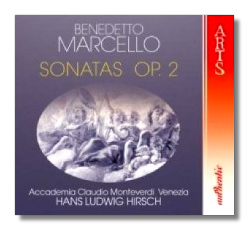
The Internet's Premier Classical Music Source
Related Links
- B. Marcello Reviews
- Latest Reviews
- More Reviews
-
By Composer
-
Collections
DVD & Blu-ray
Books
Concert Reviews
Articles/Interviews
Software
Audio
Search Amazon
Recommended Links
Site News
 CD Review
CD Review
Benedetto Marcello

12 Sonatas for Flute & Continuo, Op. 2 (1712)
- Sonata #1 in F Major
- Sonata #2 in D minor
- Sonata #3 in G minor
- Sonata #4 in E minor
- Sonata #5 in G Major
- Sonata #6 in C Major
- Sonata #7 in B Flat Major
- Sonata #8 in D minor
- Sonata #9 in C Major
- Sonata #10 in a minor
- Sonata #11 in G minor
- Sonata #12 in F Major
Accademia Claudio Monteverdi Venezia/Hans Ludwig Hirsch
Arts 47790-2 DDD 2CDs 57:57, 52:13
Benedetto Marcello (1686-1739) and his older brother Alessandro were sons of a rich and long-established family of merchants and community leaders in Venice. When Alessandro showed a taste and aptitude for music, Benedetto was steered into a career as a civil servant, as if to ensure that the family's reputation would be upheld. However, he too had been bitten by the bug, and both sons became composers. For some time, the popularity of Benedetto's music eclipsed even Vivaldi's – incidentally, both wrote music for the orphans in the Ospedale della Pietà – although Vivaldi had the last laugh: today his music is almost inescapable, while Benedetto Marcello's is performed far less frequently. (Fate has been equally unfair to his brother Alessandro.)
Benedetto's style is less flashy than Vivaldi's, as if, knowing that he was not dependent on music to earn his livelihood, he didn't have to cater to the whims of virtuosos. Like Vivaldi, however, his music is full of typically Venetian songfulness – sweet, with just a touch of melancholy. The 12 sonatas that comprise his Op. 2 were not necessarily conceived as a cycle. The various editors who have edited this opus – Sala, Roger, and Walsh – even have placed the sonatas in differing orders. Hirsch and the Accademia Claudio Monteverdi Venezia have looked to all three editors in preparing this recording to come up with a sort of hybrid performance.
As played here, of the 12 sonatas, five feature the recorder ("flauto dolce"), four the transverse flute, and three the violin. The continuo instruments are the lute (or chitarrone), cello, harpsichord, and organ. In some sonatas, there is only one continuo instrument (harpsichord or cello), but most of them call for two. This creates variety of timbre, which makes it easy to hear all 12 sonatas in one sitting, if one so chooses.
These performances date back to 1985 and are now reissued at mid-price. Although there is nothing to indicate this in the accompanying material,"period instruments" are used here, or replicas thereof, and their sound has plenty of personality and bite. Luigi Rivighi's violin rasps with character, and the flute and recorder as played by Susanne Schaffert and Gianni Lazzari (perversely, Arts doesn't tell us who plays which instrument, except to tell us that both play the flute) are soulfully breathy, with color provided by the "bent" pitches typical of period wind instruments. Stylistically, everything is as it should be, and tempos are well-judged. This is not one of those recordings in which "authenticity" is taken to mean playing Allegros so fast as to be unintelligible. The performers have taken a flexible approach to repeats, including them (with embellishments) when to do seems appropriate, but omitting when they seem de trop. I really enjoyed these performances; two hours flew by.
The booklet notes, originally written in Italian, have been translated into unidiomatic, poorly proofread, and occasionally amusing English – what, for example, is a "lasso continuo"? (I suspect it was used by Venetian cowboys.)
Copyright © 2007, Raymond Tuttle




















